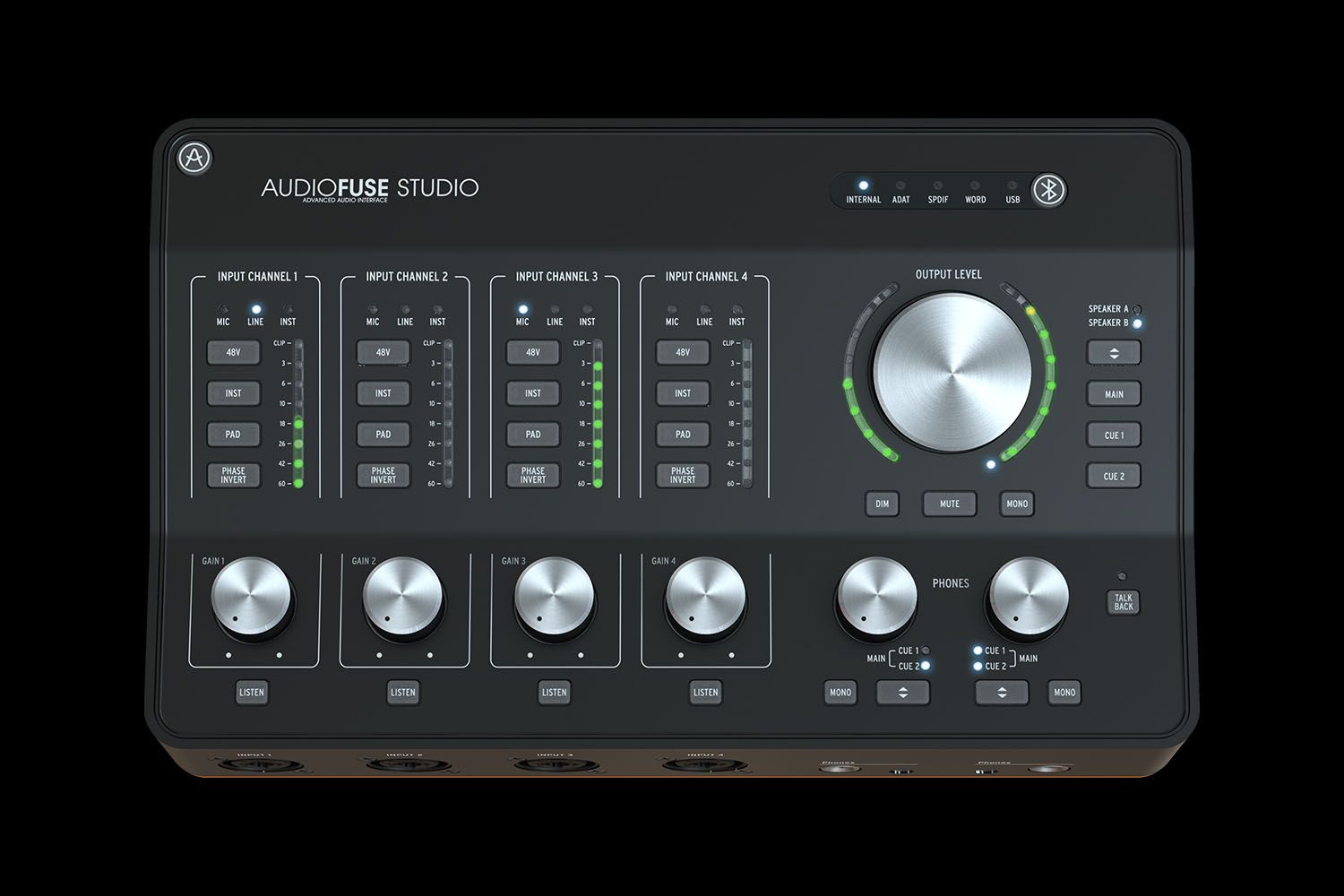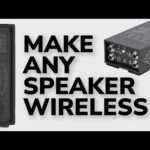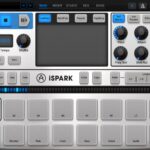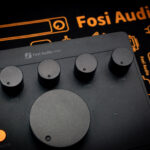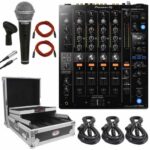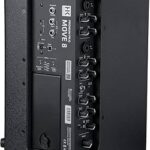Discover the Arturia AudioFuse audio interface in our comprehensive review. Explore its 14 ins and outs, premium preamps, flexible power options, and professional studio features perfect for recording, mixing, and production.
Arturia AudioFuse Audio Interface Review: Professional Studio Connectivity Redefined
A Full-Featured Audio Interface That Serves as Your Studio Hub
The Arturia AudioFuse represents a significant leap forward in professional audio interface design, combining extensive connectivity options with premium sound quality in a compact, studio-ready package. This USB audio interface delivers 14 inputs and outputs, MIDI I/O, and even includes a built-in USB hub, making it an ideal centerpiece for modern production environments ranging from home studios to field recording setups.
Flexible Power Options for Every Scenario
One of the AudioFuse’s standout features is its versatile power configuration. The interface can operate using either the included DC power supply or bus power from your Mac or PC, providing flexibility for different working environments. When connected via DC power supply, the AudioFuse delivers an impressive 24 dB of headroom on both input and output. Switch to bus-powered mode, and you’ll still enjoy a respectable 18 dB of headroom on both input and output—more than sufficient for professional applications.
For iOS users planning mobile recording sessions with an iPad, the DC power supply becomes essential. The power supply also enables the built-in USB hub to function at full capacity, allowing you to bus power up to three different devices simultaneously. This USB hub functionality proves invaluable for expanding your computer’s connectivity, enabling seamless integration of dongles, master keyboards, and other USB peripherals while maintaining access through your primary computer.
Comprehensive Input Configuration
The AudioFuse provides simultaneous access to four analog inputs, with two featuring dedicated mic or instrument level preamps. Inputs 1 and 2 offer the most flexibility, with front-panel connections that accept microphone, line level, or instrument level signals. These channels feature high-quality preamps capable of delivering between 2 dB and over 75 dB of gain, ensuring clean amplification even for low-output microphones.
Analog inputs 3 and 4, located on the rear panel, can be configured for line level input, with input 3 also supporting instrument level signals. A particularly noteworthy feature is the ability to switch inputs 3 and 4 to accept signals from the built-in phono preamp, making the AudioFuse an excellent choice for DJs and producers who work with vinyl records. All input configuration changes are managed through the intuitive control panel software.
The interface also includes insert points for inputs 1 and 2, allowing you to route signals through external processing gear like compressors and equalizers during tracking. Alternatively, these insert jacks can function as direct line inputs, bypassing the preamps entirely to feed signals straight to the analog-to-digital converters.
Versatile Output Architecture
With eight analog outputs, the AudioFuse supports complex monitoring setups. The interface provides two pairs of stereo speaker outputs (Speaker A and B), switchable via a front-panel control or through the software control panel. This dual-speaker configuration allows you to reference your mixes on different monitoring systems without rewiring your studio.
The two independent headphone outputs offer both quarter-inch and 3.5mm connections, eliminating the need for adapters. These outputs, combined with the speaker outputs, enable three simultaneous mixes—perfect for situations requiring a main mix through the speakers, one cue mix for headphone output 1, and a separate cue mix for headphone output 2. Each output has dedicated level controls and can be easily selected using front-panel switches or the control panel software.
Premium Microphone Preamps with Documented Performance
The microphone preamps in the AudioFuse deliver exceptional performance, with each unit shipping with a certificate of specifications unique to that particular interface. This certificate documents the EIN (Equivalent Input Noise) rating, frequency response, and gain range for your specific unit, demonstrating Arturia’s commitment to quality control.
Typical specifications show EIN ratings better than -131 dB, with frequency response spanning from 20 Hz to 20 kHz that’s flat within an impressive 0.56 dB. This remarkably flat response ensures accurate sound reproduction across the entire audible spectrum. The preamps provide sufficient gain for even the most demanding ribbon and dynamic microphones, with ranges typically extending from approximately 2 dB to 76 dB.
Digital Connectivity and Synchronization
For digital workflows, the AudioFuse includes both 8-channel ADAT and stereo S/PDIF I/O, dramatically expanding your channel count when working with external converters or digital equipment. The interface also features word clock input and output, enabling precise synchronization with other digital audio devices in your studio.
MIDI connectivity comes via rear-panel MIDI In and MIDI Out connections using 3.5mm connectors. Arturia includes the necessary breakout cables, ensuring compatibility with standard 5-pin MIDI devices without requiring additional adapters.
Intuitive Front-Panel Control
One of the AudioFuse’s most appreciated design elements is its comprehensive front-panel control layout. Nearly every function is accessible via dedicated buttons without diving into menus or software, streamlining your workflow during recording and mixing sessions.
The input channel controls for channels 1 and 2 include buttons for 48-volt phantom power (available even when bus-powered), phase invert, a pad/boost function with three positions (boost, unity, and pad), and instrument mode selection. Each input features a rotary level control with adjacent LED metering, providing clear visual feedback of your input levels.
The central monitor control section features a large volume knob surrounded by LED metering rings that display output levels. Control switches allow you to select between cue 1, cue 2, or main mix for your speaker outputs, as well as buttons for mono summing, dim (with adjustable depth set in software), mute, and Speaker A/B selection.
The two headphone output controls sit at the bottom of the front panel, each with its own source selector (cue 1, cue 2, or main), mute button, and independent level control. A built-in talkback microphone feeds into two stereo outputs routable to your computer or any output destination, with activation via press-and-hold functionality.
Advanced Software Control Center
The AudioFuse Control Center software provides deeper access to the interface’s capabilities. Digital settings include sample rates from 44.1 kHz to 192 kHz at 24-bit resolution, clock source selection (internal or external), and independent format selection for digital input and output (S/PDIF, ADAT, or word clock).
The software mirrors the front-panel controls while adding configuration options for inputs 3 and 4, including phono/line switching, independent padding, and instrument mode for input 3. A comprehensive direct monitoring mixer shows routing for all inputs to main, cue 1, and cue 2 outputs, with talkback routing and level control.
The preferences panel reveals advanced options including power mode selection (Auto, DC, or bus-powered), mixdown modes that disable inputs to maximize output bandwidth, visual skin selection, independent or linked operation for Speaker A and B outputs, and trim controls for matching different monitor levels. You can also adjust the dim amount and set digital input termination.
A unique feature is the ability to configure Speaker B output as a reamping output, allowing you to route direct-recorded guitar signals from your DAW back out to an amplifier for re-recording with different tones—a creative tool for guitarists and producers.
Who Should Choose the AudioFuse?
The Arturia AudioFuse is ideally suited for producers, engineers, and musicians who require professional-grade audio quality with exceptional routing flexibility. Its combination of pristine analog preamps, extensive digital I/O, and thoughtful features like the phono preamp and reamping capability make it particularly attractive for:
- Home and project studio owners seeking a high-quality central hub
- Mobile recording engineers who need professional features in a portable package
- Electronic music producers working with synthesizers and drum machines
- DJ/producers who incorporate vinyl records into their productions
- Guitarists and multi-instrumentalists recording in home environments
Portable Protection
Understanding that many users will take the AudioFuse on location, Arturia includes a protective cover that snaps over the top of the interface, safeguarding controls and connections when the unit is transported in a computer bag or equipment case.
Conclusion
The Arturia AudioFuse delivers on its promise of being an incredibly full-featured audio interface. Its combination of pristine audio quality, extensive connectivity options, flexible power configurations, and intuitive operation make it an excellent choice for serious recording applications. Whether you’re building a home studio, upgrading your mobile recording rig, or simply seeking a high-quality interface that can grow with your needs, the AudioFuse offers professional performance with the versatility modern producers demand.
The inclusion of features like the built-in USB hub, phono preamp, reamping capability, and comprehensive routing options demonstrates Arturia’s understanding of real-world production workflows. With its documented specifications, premium components, and thoughtful design, the AudioFuse stands as a compelling option in the professional audio interface market.


